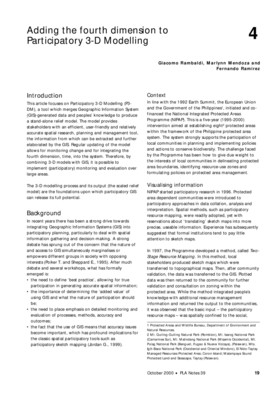Adding the fourth dimension to Participatory 3-D Modelling
Document begins: Adding the fourth dimension to 4 Participatory 3-D Modelling Giacomo Rambaldi, Marlynn Mendoza and F e rnando Ramire z Introduction Context This article focuses on Participatory 3-D Modelling (P3- In line with the 1992 Earth Summit, the European Union DM), a tool which merges Geographic Information System and the Government of the Philippines1, initiated and co- (GIS)-generated data and peoples' knowledge to produce financed the National Integrated Protected Areas a stand-alone relief model. The model provides Programme (NIPAP). This is a five-year (1995-2000) stakeholders with an efficient, user-friendly and relatively intervention aimed at establishing eight2 protected areas accurate spatial research, planning and management tool, within the framework of the Philippine protected area the information from which can be extracted and further system. The system strongly supports the participation of elaborated by the GIS. Regular updating of the model local communities in planning and implementing policies allows for monitoring change and for integrating the and actions to conserve biodiversity. The challenge faced fourth dimension, time, into the system. Therefore, by by the Programme has been how to give due weight to combining 3-D models with GIS, it is possible to the interests of local communities in delineating protected implement (participatory) ...
Cite this publication
Available at https://www.iied.org/g01908
